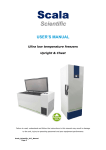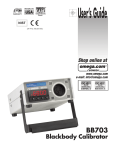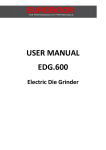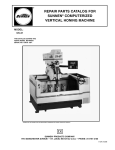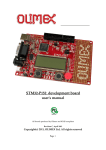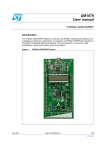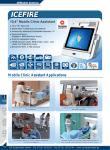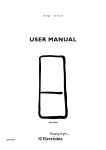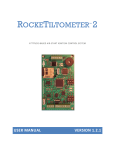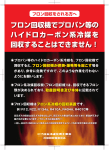Download Series - Scala Scientific
Transcript
Series User Manual, version 1.9 21/10/2011 Laboratory Refrigerators (+1 / +8 °C) Laboratory Freezers (-18 / -22 °C) Plasma Freezers (-18 /-35 °C) Blood Bank Refrigerators (+4 °C) Combination Fridge / Freezer (+4 / -35 °C) Failure to read, understand and follow the instructions in this manual may result in damage to the unit, injury to operating personnel and poor equipment performance Quick Installation Guide 1. Recommended room conditions a. Recommended room temperature: between 5 and 33 ºC; *If the room temperature is normally > 30 ºC please ensure that suitable air-conditioning is installed. b. Make sure the floor is level and even. c. 30 centimetre free space at the back and both sides of the unit is required for proper air circulation. 2. Turning Slimline ON and Time setting a. Push the power plug firmly into the power socket; (please check you have the correct voltage); b. By pushing the button, the display will light; c. In case ‘rtC’ is displayed you need to set the time; d. Hold for 5 seconds until ‘HUR’ will be displayed on upper display; e. Push the button, the time digit starts flashing; f. Set the time with the and buttons; g. Confirm the settings by pressing the button again; h. Repeat this procedure for the other clock parameters (step ‘e’ to ‘g’): Min: minutes (0-60) UdA: which day (Sun, Mon, TuE, Ued, tHU, Fri, SAT) dAy: which day (1-31) Mon: which month (1-12) yEA: year (00-99) Hd1, Hd2, Hd3: are the days for the defrost cycle (standard on all days of the week) 3. Set Temperature Original set points are factory set and give the Slimline the optimum conditions for prolonged life; a. Press the button, the display will flash; b. By pushing the and buttons the set point can be adjusted; c. Confirm the set-point by pressing the button again; 4. Recommended maintenance a. We recommend to clean the condenser filter of dust every month; b. We recommend a maintenance visit by your local dealer on an annual basis. We wish you a quick and trouble free installation! Contents 1. Dimensions 4 2. Specifications 7 3. Use 9 4. Technical Data 9 5. Temperature Range 9 6. Installation 10 7. Temperature Controller 11 8. Function of the Controller 13 8.1 Connection to mains 8.2 Switching the unit ON 13 13 8.3 8.4 8.5 8.6 8.7 8.8 13 14 14 15 15 15 Time setting Black Out Alarm Setting Temperature Set Point Standard running conditions Display during running conditions Display during alarm conditions 8.9 Detecting Alarms 8.10 Cancelling Alarms in memory 8.11 Menu functions 16 16 17 8.12 Switching the unit OFF 8.13 Temperature probes 8.14 Automatic Defrosting 8.15 Melt water evaporation 17 17 18 18 8.16 Probe Breakdown Safety 8.17 Alarm Messages 18 18 9. Connection Diagram 19 10. Refrigerant Information 20 11. Cleaning and Maintenance 21 11.1 Cleaning the condenser 11.2 Cleaning the cabinet 11.3 Replacing the lamp 21 21 21 12. Chart Recorder 22 12.1 Changing the chart paper 12.2 Replacement of pen 12.3 Pen arm calibration 12.4 Temperature recorder calibration check 22 22 23 24 12.5 Battery backup 12.6 Battery location and replacement 24 24 12.7 Chart “range” selection 25 13. Warranty & contact information 26 13.1 International Warranty 13.2 Conditions and terms of sale 26 26 13.3 Contact information 26 1. Dimensions Dimensions of models LR700, LR700G, LF700, LRF300 and LDF700 Dimensions of models LR1400, LR1400G and LF1400 Clarification: Power Supply Cable Outlet Racks Pitch In case of using our special casters, height will be reduced down to 1985 mm 4 Dimensions of Blood Bank Refrigerator model BB700 Dimensions of Blood Bank Refrigerator model BB1400 Clarification: Power Supply Cable Outlet Racks Pitch In case of using our special casters, height will be reduced down to 1985 mm 5 Dimensions of Blood Plasma model BP700 Dimensions of Blood / Plasma Combination model BBP300 Clarification: Power Supply Cable Outlet Racks Pitch In case of using our special casters, height will be reduced down to 1985 mm 6 2. Specifications High quality cabinet construction Only Slimline® uses standard stainless steel interior and exterior on all products. Guides and grids are tilt proof and are able to slide out to have easy access to the samples. Rails can be easily mounted and dismounted by hand. Internal corners are all rounded, to assure quick and easy cleaning. Temperature uniformity and recovery All temperature configurations offer forced air circulation by internal fans to ensure high temperature uniformity and fast temperature recovery. The 1400 double doors series even uses double evaporator fans to ensure extreme uniformity. Fans stop automatically when the door is open. Doors are self closing when opened within a position of 90° User friendly and maintenance free! Optional glass doors are lighted by dual bulb lights and even the standard fixed doors are lighted by a 25 W lamp. The cabinets are defrosted automatically and melt water is evaporated automaticaly in a heated tray located on the back of the cabinet. UltraSafe® temperature control system A transparant cover is protecting the UltraSafe® controller. The control system is a very complete and easy to program system with following standard features: • • • • • • • • Adjustable temperature set point; High temperature alarm; Low temperature alarm; Alarm history list; Date, time and buzzer; Door open alarm; Dry contact for remote alarm; Light on/off; 7 Unique traceability of alarms with storage history of last 20 alarms: In case of temperature alarm: (1) time of start of the alarm; (2) time of end of alarm; (3) most critical temperature reached and the time; In case of power failure: (1) date and time of power failure; (2) time of end of alarm; (3) critical temperature listed when unit had power again; Combination Line: Two for One This is the answer for small laboratories which need blood and plasma storage in one small footprint. The ideal solution when space, dual temperature control and performance are critical. Blood Bank Refrigerators and Plasma Freezer features All blood bank refrigerators have standard double layer glass doors with dual bulb light and durable stainless steel roll-out drawers. The standard 7-day chart recorder with battery backup ensures constant operation during power failures. Optional PLC touch screen • two sensors monitor and data log temperature in both the upper and lower part of the cabinet; • control and readout on colour touch screen; • • • 12-hour history in graphs and tables; alarm for temperature, door ajar, power, compressor and ambient; special service menu with password with compressor and ambient temperature registration. 8 3. Use The Slimline equipment is intended for storage of samples within the specified range of temperature. Every other use is to be considered as not proper. In this case, Skadi Europe shall not be liable under any circumstances. 4. Technical Data - Voltage - Absorbed power - Refrigerants - Insulation thickness (CFC free polyurethane) 230 volt / 50Hz check on the equipment tag - R404a - R290 natural refrigerant (optional) 60mm Further data is available on the CE serial number tag, applied internally at the upper left wall of the unit. 5. Temperature range To identify the proper working range of the cabinet, refer to the first code letters, visible on the inner CE serial number tag. SERIE “LR” serie “LF” serie “LRF” serie “LDF” serie “BB” serie “BP” serie “BBP” serie TEMPERATURE RANGE +1°C to +8°C –18°C to –22°C +1°C to +8°C and –30°C to –35°C –18°C to –35°C +1°C to +8°C –18°C to -35°C +1°C to +8°C and –30°C to –35°C It is strongly recommended to use the cabinet within the specified range. 9 6. Installation WARNING!! THE INSTALLATION MUST BE EXCLUSIVELY DONE BY A SPECIALIST. Integrity: Verify the integrity of the cabinet in all parts, as well as the presence of the specified accessories; Cleaning: Remove the protective PVC film present at the outside of the cabinet. Clean the inner room with a wet warm sponge; Environment Conditions: Be sure that the environment in which the cabinet is installed complies with the following requirements: - Room temperature between + 5°C and +33°C - No heath sources should be near to the cabinet. - The room should be properly ventilated Placement: Place the cabinet in the final position and make sure this is level. For this the adjustable legs can be used which are adjusted by turning the bottom side of the leg. Make sure that you keep 30 centimetre free space at the back and both sides of the unit for proper air circulation. Working conditions: Before connecting the cabinet to main power, check that electrical tension and frequency comply with the specified values on the inner CE tag, placed at the upper left wall. Standard tolerance is of +/- 10 % of the nominal value; The power supply shall comply with the rules in force; A safety device must be present in the electrical plant to which the cabinet is connected. Connection to earth is compulsory. 10 7. Temperature Controller L1 L3 L2 DY T1 T2 T3 T4 T5 T6 T1 °C Increase (UP) T4 °C decrease (DOWN) T2 Menu T5 Parameters setting T3 Lamp lighting on/off T6 On/Off switch L1 Led: lamp switched on L2 Led : compressor on L3 Led : defrost on DY 11 Display Display DY Temperature Time Icons Explanation of the icons: 12 8. Function of the Controller 8.1 Connection to mains By inserting the power plug into the power socket the cabinet enters the STAND-BY phase, shown by lighting of the led corresponding to button T6 In case the cabinet is kept idle for long periods of time, it is advisable to disconnect the plug from the socket. 8.2 Switching the unit ON By pushing the T6 button, the corresponding led switches off and the display DY gets lighted The uppers digit show the temperature being measured by the probe inside of the cabinet. The lower digits indicate the time. In this phase the led L2 will flash for approximately one minute (depending on the start delay of the compressor that has been set). The compressor is still switched off. Once the delay is over, the led L2 stays switched on, and the compressor starts. Once started, the compressor will work continuously in order to reach the set temperature. 8.3 Set Time When the cabinet is firstly started, it is necessary to set the clock, and cancel the “black out” alarm. If the instrument shows the message ‘rtC’ alternating with temperature value, you must set the time. 13 Procedure how to set the time: a. Hold for 5 seconds until ‘HUR’ will be displayed on upper display; b. Push the button, the time digit starts flashing; c. Set the time with the and buttons; d. Confirm the settings by pressing the button again; e. Repeat this procedure for the other clock parameters (step ‘e’ to ‘g’): Min: UdA: dAy: minutes (0-60) which day (Sun, Mon, TuE, Ued, tHU, Fri, SAT) which day (1-31) Mon: which month (1-12) yEA: year (00-99) Hd1, Hd2, Hd3: are the days for the defrost cycle (standard on all days of the week) 8.4 Black Out Alarm The Black Out alarm function only works in case the clock is set at the time of alarm. The black out alarm will be shown as soon as the unit is connected again at the moment of a temperature alarm. The saved data of the black out alarm are: - Time indication when power went off ( date and time) Time indication when power came back (date and time) Highest measured temperature ( date and time) Of course a black out alarm will occur every time a unit is switched on and off again. To reset the black out alarm at these times press SET 8.5 Setting Temperature set point The set point is the value of set temperature that the cabinet will reach and keep with a tolerance of +/- 2 °C. a. Press the button, the display will flash; b. By pushing the and buttons the set point can be adjusted; c. Confirm the set-point by pressing the button again; 14 8.6 Standard running conditions: Once a set point is reached, the led L2 stops. switches off and the compressor The compressor will stay switched off until the temperature arises 2°C above the set point. At that point the led L2 starts again and the cycle is repeated. switches on again and the compressor During the defrosting phases, the compressor keeps running 8.7 Display during running conditions Standard working conditions: Upper display: actual temperature Lower display: actual time (together with clock symbol) 8.8 Display during alarm conditions Alarm conditions: Upper display: actual temperature Lower display: difference between the actual temperature and the set temperature, indicated by the ‘dF’ symbol High temperature alarm 15 8.9 Detecting alarms 1. Push the Up button; 2. On the upper display the last happened alarm, identified by its number, is shown; On the lower display the following types of alarm may be shown: - HIt: High temperature alarm Lot: Low temperature alarm Blou: Black out alarm - GEAL: generic alarm incoming from the digital port 3. Further pushing on the Up button, all alarm codes from the oldest to the more recent ones are displayed; 4. To check when a certain alarm happened, its duration and the maximum reached temperature, push the SET button; 5. Starting time and date of the alarm will be visible together with the icons of clock and calendar, and the message: ‘from’ 6. Pushing again the Up button, ending time and date of alarm are shown on the display together with the message: ‘to’ 7. Pushing once more the Up button, the critical temperature being reached is shown together with time and date. The icons:alarm and critical temperature blink. 8. Push the ‘M’ menu button to exit 8.10 Canceling alarms in memory 1. Enter the menu functions by pressing the ‘M’ button; 2. Select function ‘rSt’, then push the SET button 3. In case it is required, insert the password, otherwise the alarms will be immediately cancelled. 16 8.11 Menu functions To enter the Menu press the ‘M’ button; Functions available: - rSt: It is used to cancel all alarms in memory. The function may be protected by a password. On lower display the date and time of last canceling will be displayed. At first installation the instrument will show only zeroes; - Lot: Limit for minimum temperature alarm It may be protected by a password; - HIt: Limit for maximum temperature alarm. It may be protected by a password - ir: in case infrared port is used - PASS: to enter and modify the password To leave the Menu press the automatic leaving the menu. ‘M’ button or wait for 15 seconds for 8.12 Switching the unit OFF Pushing the T6 button, the compressor and fans will stop. For a few seconds he message OFF will appear on the display DY The button T6 will be lighted, and the cabinet will enter in STAND-BY mode. In this mode no functions are activated. Only the lighting button will operate. 8.13 Temperature probes Inside the cabinet, two NTC temperature probes are present: Probe 1 measures the internal cabinet temperature Probe 2 measures the temperature of the evaporator which optimises the operating of the fans and reduces defrost times. 17 8.14 Automatic Defrosting Defrosting cycles are fully automatic. The electronic thermostat causes the defrosting cycles run according to the set intervals. Each defrosting cycle has been optimised in order to last the shortest needed time. The defrosting cycle stops when the Probe 2 (placed at the evaporator) detects the limit temperature for defrosting. Duration of defrosting may vary, according to the actual conditions. To modify the defrosting intervals you must always contact a specialist 8.15 Melt water evaporation The water generated from the defrosting cycle is automatically eliminated by an evaporating stainless steel heated tray, placed at the back of the cabinet 8.16 Probe breakdown safety In case one of the probes break down, the relevant alarm is shown on the display DY, an the emergency mode is activated. This emergency mode will continue managing the compressor cycles. With this safety mode the samples will be safe until arrival of technical service. 8.17 Alarm Messages In case of an alarm, the information / alarm message on the display DY will be shown until the alarm conditions are over. All alarm messages are flashing. - “HA” High temperature alarm: Inner room temperature is too high. This alarm will automatically end as soon as the temperature goes back to the set point range, when a defrosting cycle is started, or when the door is opened; - “LA” Low temperature alarm: Inner room temperature is too low. This alarm will automatically end as soon as the temperature goes back to the set point range, when a defrosting cycle is started, or when the door is opened; - “P1” Probe 1 breakdown: The probe which measures the inner cabinet temperature is broken. In case the alarm will not recover: call your local dealer; 18 - “P2” Probe 2 breakdown: The probe which measures the evaporator temperature is broken. In case the alarm will not recover: call your local dealer; - “dA” Door open alarm: This alarm sounds in case the door is kept open for more than 5 minutes. This alarm will recover as soon as the door is closed again. 9. Connection Diagram 19 10. Refrigerant Information Model Refrigerant Slimline Refrigerant information Charging Compressors Quantity(g) 350 2/3 HP Max. Amps 3,3 LR700 R404A LR700G R404A 350 2/3 HP 3,5 LR1400 R404A 450 1 HP 4,3 LR1400G R404A 450 1 HP 4,5 LF700 R404A 450 2/3 HP 3,3 LF1400 R404A 500 1 2/3 HP 6,6 LDF700 R404A 500 1 1/3 HP 5,6 LRF300 R404A 1/2 HP & 2/3 HP 5,0 BB700 R404A 350 2/3 HP 3,3 BB1400 R404A 450 1 HP 4,3 BP700 R404A 500 1 1/3 HP 5,6 BBP300 R404A 250 / 350 1/2 HP & 2/3 HP 5,0 250 / 350 20 11. Cleaning and Maintenance WARNING!!! Before starting any activity of cleaning or maintenance, disconnect the cabinet from electrical power Standard maintenance operations can be performed by any operator in case following instructions are followed 11.1 Cleaning the condenser It is advisable to perform regular cleaning of the condenser in order to make sure the efficiency of the refrigerating unit is optimal. Use a brush with soft hair and a vacuum cleaner to clean the aluminium fins carefully. The condenser features sharp edges. Perform cleaning by wearing protective gloves. 11.2 Cleaning the cabinet Inner and outer surfaces can be washed by use of a soft sponge, warm water and chemically not aggressive detergents. Once the surfaces are cleaned, wipe and dry by using a soft clean cloth. In case using products in order to shine the stainless steel: Use only on the outer surfaces. Washing by pouring or spraying water is not permitted 11.3 Replacing the lamp Disconnect the cabinet from main power. Unscrew the transparent cover. Take the lamp out and replace it for a new one. Place the cover back. All data being reported in this manual are actual to models presently in production. Skadi Europe reserves the right to apply improvement modifications to its products, notifying them only in the new editions of the manuals. 21 12. Chart Recorder All models of the Blood Bank line, BB700, BB1400, BP700 and BBP300 standard come with a 4”chart recorder. Also this recorder can be ordered with all other models as an option. All chart recorders are factory installed. Please contact our service department in case the exceptional case you need to install a recorder on-site. 12.1 Changing the chart paper Press and hold the "change chart" button (#3) for approximately one (1) second until the pen begins to move to the left of the chart and then release the button. Wait until the pen has moved completely off of the chart. To remove the chart paper, unscrew (counter-clockwise) the chart "hub" knob at the centre of the chart. Remove the old chart paper and position the new one so that the correct time line coincides with the time line groove on the chart plate. Refer to following figure for the location of the time line groove. Re-attach the chart "hub" knob and screw securely (by hand) against the chart. Press and hold the "change chart" button (#3) again for approximately one (1) second until the pen begins to move back onto the chart and then release the button. Check to make sure that the pen is marking on the chart paper. If it is not, then carefully adjust the pen arm to establish contact with the paper. 12.2 Replacement of pen Recorders that are equipped with fibre tipped cartridge pens will have a cartridge that is colour coded "red" to designate pen number one (1). The pen cartridge is securely fastened to the metal pen arm using a special "U" clip tab. 22 For ease of replacement, it is suggested that the two (2) screws that hold the pen arm be loosened and the pen cartridge and metal pen arm be removed as an assembly. Refer to the following figure for the location of the pen arm screws. Unsnap the plastic "U" clip tab of the pen cartridge from the metal pen arm, remove and discard the old pen cartridge. Replace the new cartridge by opening the hinge and snapping it securely around the metal pen arm. Refer to the figure above. 12.3 Pen arm calibration To check and/or adjust the recording pen calibration to the outer most temperature graduation of the chart, press and hold the "change chart" button (#3) until the pen begins to move off of the chart. Once the pen has moved off of the chart, again press and hold the "change chart" button (#3) until the pen begins to move back onto the chart. The pen should briefly stop at the outer most temperature graduation of the chart before continuing onto the chart to begin recording. If the pen does not stop exactly at this location on the chart, it can be adjusted or "calibrated" by using the left (#1) or right (#2) arrow buttons When the pen moves back onto the chart and briefly stops, you will have approximately five (5) seconds in which to adjust the pen's position using the left and right arrow buttons. Each time the chart paper or fibre tip pen cartridge is changed, you should make sure that each pen stops at the outer most temperature graduation of the chart paper. Otherwise, this pen offset will cause the unit to record an incorrect temperature on the chart. 23 12.4 Temperature recorder calibration check This recorder has been accurately calibrated at the factory. Before making any adjustments, this instrument should be in service for 24 hours. Thereafter, if any adjustment is required, perform the following procedure: 1. Place a Certified Test Thermometer(s) in a solution bottle(s) alongside the recorder's sensor probe(s). 2. Once the temperature has levelled out, compare the position of the pen on the recorder to the test thermometer's reading. 3. If an adjustment is required, use the left (#1) and right (#2) arrow push buttons on the recorder to calibrate (or move) the pen's position on the chart to correspond to the temperature of the solution. The arrow buttons must be held for approximately five (5) seconds before the pen will begin to move. 12.5 Battery backup The green LED light remains a constant green colour indicating that both the battery and the main power to the unit are good. If the AC power were to fail or the battery becomes weak, then the green LED light will begin "flashing" indicating that either you have lost the main power to the unit or it is time to replace the battery. Having a 9 volt DC battery back-up in place, will allow the recorder to continue to function normally for approximately 24 hours in the event of a power failure. 12.6 Battery location and replacement To replace the battery, first open the recorder door. The battery will be located in the upper right hand corner of the unit. Note: Use only NEW 9 volt alkaline replacement batteries. 24 12.7 Chart “range” selection The recorder that you are using has a range sticker (that lists several temperature ranges) mounted on the front of the chart plate. This recording unit has the option for the user to select from several temperature "ranges" that are programmed into the recorder. Note: The chart paper that is used on the recording unit must match the range that is selected for the recorder. Otherwise, the pen's position on the chart paper will not correspond to the temperature that is measured. Also, if the pen moves to the centre or outer edge of the chart and remains there while the unit is powered on, then this maybe an indication that the current range that is selected for the unit is not correct. The recorder has a built-in safety mechanism that will always move the pen to the highest temperature on the chart when the current temperature that is measured is not within the selected range. This recording unit has five (5) user selectable ranges programmed into the unit. To select from one of the available ranges, follow these instructions: After the recording unit has been powered-on and is operating normally (recording temperature), press and hold the "change chart" button (#3) until the pen arm begins to move off of the chart. Once the pen has moved off of the chart, press and hold the left arrow (#1) or right arrow (#2) button for approximately five (5) seconds and then release the button. The green LED light will begin flashing one (1) time if range #1 is selected or will flash two (2) times if range #2 is selected and so on. Press the left arrow button (#1) to increase the range number or press the right arrow button (#2) to decrease the range number that is selected for the recorder. When you have finished selecting the range, press and hold the "change chart" button (#3) until the pen begins to move back onto the chart and the selected range will be saved into the recorder's permanent memory. Note: The correct range for your purchased Slimline is factory set. Changing of chart range is not necessary. 25 13. Warranty & contact information 13.1 International Warranty The warranty period starts at the moment the unit leaves the production facility. After this date two year warranty on parts is valid. During these first 2 years component parts proven to be defective can be send to your local dealer and will be covered by this 2 years warranty on parts only. Expendable items, i.e., glass, filters, pilot lights, light bulbs and door gaskets are excluded from this warranty. Skadi Europe will not be liable for any indirect or consequential damages including, without limitation, damages relating to lost profits or loss of products. 13.2 Conditions and terms of sale All prices are ex works from the Skadi Europe Warehouse in The Netherlands, excluding insurance, seaworthy packing and customs duty. Effective prices are those valid on date of confirmation of order. All specifications mentioned in the price list are based on 230 V / 50Hz power supply. Continuing research and improvements may result in specification changes. Errors and misprints excepted. 13.3 Contact information In case service or sales back up is needed please do not hesitate to contact your local Skadi Dealer: Or contact the European Skadi Headquarter: Skadi Europe Kryptonstraat 11 6718 WR EDE The Netherlands [email protected] www.skadi-europe.com tel: +31 318 64 64 81 fax: +31 318 64 60 31 26 NOTES …………………………………………… …………………………………………… …………………………………………… …………………………………………… …………………………………………… …………………………………………… …………………………………………… …………………………………………… …………………………………………… …………………………………………… …………………………………………… …………………………………………… …………………………………………… …………………………………………… …………………………………………… …………………………………………… …………………………………………… …………………………………………… …………………………………………… …………………………………………… …………………………………………… …………………………………………… …………………………………………… …………………………………………… …………………………………………… …………………………………………… …………………………………………… …………………………………………… …………………………………………… …………………………………………… …………………………………………… …………………………………………… …………………………………………… …………………………………………… …………………………………………… …………………………………………… …………………………………………… …………………………………………… …………………………………………… …………………………………………… …………………………………………… …………………………………………… …………………………………………… …………………………………………… …………………………………………… …………………………………………… …………………………………………… …………………………………………… …………………………………………… ………………....................................... ............................................................. ............................................................. ............................................................. ............................................................. ............................................................. ............................................................. ............................................................. ............................................................. ............................................................. Corporate identity of Skadi The word Skadi is originating from the Nordic mythology (Skaõi). Skadi is a powerful goddess of winter. Together with her wolf she survives in the bitter cold mountains. Delivering quality through service Disclaimer: Information contained throughout our brochures, web pages and offers is believed to be accurate and reliable at the time of publishing. There may be misprints, human errors, and omissions. We reserve the right to make changes and corrections in prices, products, and specifications without notice. Images displayed on our brochures, web pages and offers should be regarded as illustrative and informational purpose only. The actual products are often not identical to the images. Version 1.9 (2011) Copyright© Skadi Europe, The Netherlands 2011
































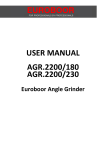


![User Guide [ ] - American Industrial Systems, Inc.](http://vs1.manualzilla.com/store/data/005740554_1-2a4ebbae5daccebd80088e03c7d32b9b-150x150.png)




